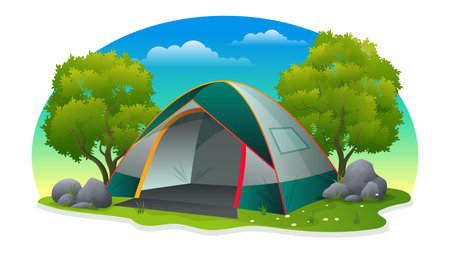1. Understanding the Basics of Backpack Frame Types
When youre planning a camping trip, one of the most important pieces of gear youll need is a backpack that suits your needs. Backpacks come in two main frame styles: internal and external. To choose the right one, its helpful to understand how they’re built, where they came from, and what kind of adventures they’re best for.
What Is an Internal Frame Backpack?
An internal frame backpack has a structure built into the pack itself. These frames are usually made of aluminum stays or plastic frame sheets sewn into the back panel. The design hugs your body closely, helping you stay balanced on uneven terrain—perfect for hiking narrow trails or scrambling over rocks.
What Is an External Frame Backpack?
External frame backpacks have a visible metal frame on the outside of the pack. The bag is attached to this rigid frame, which typically extends beyond the pack’s dimensions. These packs sit higher off your back and offer excellent ventilation and weight distribution—great for carrying heavy loads on well-groomed trails.
A Brief History
External frame backpacks were the go-to choice in the early days of recreational camping and backpacking, especially during the 1960s and 70s. Their simple yet sturdy design made them ideal for long treks with heavy gear. Internal frame backpacks gained popularity in the 1990s as outdoor adventurers began exploring more rugged terrain, leading to a demand for sleeker packs that allowed better mobility.
Typical Use Cases
| Feature | Internal Frame | External Frame |
|---|---|---|
| Terrain | Narrow trails, rough terrain | Flat or open trails |
| Load Capacity | Moderate to heavy loads | Heavy loads |
| Stability & Balance | High stability, close fit | Less stable on uneven ground |
| Ventilation | Less airflow against back | Better airflow due to space between pack and back |
| Packing Style | Tighter compartments, less external storage | More external pockets and attachment points |
Which One Fits Your Camping Style?
If youre heading into remote areas with steep climbs or winding paths, an internal frame pack might be your best bet. It moves with your body and keeps you agile. On the other hand, if youre hauling a lot of gear for family camping or covering long distances on even ground, an external frame can help carry that extra weight more comfortably while keeping your back cool.
The Bottom Line on Frames (So Far)
Choosing between internal and external frames starts with knowing what kind of trip you’re taking and what kind of comfort and support you need. Both styles have their strengths—it all depends on how and where you plan to camp.
2. Evaluating Your Camping Needs and Terrain
Before choosing between an internal frame and an external frame backpack, its important to think about where youre going, how long you’ll be out there, and what kind of weather you might face. These factors will help you decide which type of pack fits your camping style best.
Consider the Terrain
The kind of terrain youll be hiking through plays a big role in what type of backpack is right for you:
| Terrain Type | Best Frame Style | Why |
|---|---|---|
| Mountain Trails or Uneven Ground | Internal Frame | Sits closer to your body, offers better balance on rough terrain |
| Flat Trails or Open Terrain | External Frame | More ventilation and easier to carry heavy loads on even ground |
Think About the Weather
If youre heading into hot or humid areas, external frame packs offer more airflow between your back and the pack. This helps reduce sweating and keeps you cooler. On the other hand, internal frame backpacks hug your body more closely, which can keep you warmer in cold conditions but may feel sticky in warm weather.
Trip Duration Matters
The length of your trip also affects what kind of backpack youll need:
| Trip Length | Recommended Frame Type | Reasoning |
|---|---|---|
| Day Trips or Overnight | Internal Frame | Lighter and more compact, easy to carry for short durations |
| Multi-Day or Extended Trips | External Frame | Larger capacity for food, gear, and supplies; better weight distribution for heavy loads |
Packing Style Can Also Influence Your Choice
If you like to organize your gear with lots of compartments and access points, an external frame backpack might suit you better. They usually have multiple pockets and attachment points. Internal frames tend to have fewer compartments but offer a sleek design that’s easier to maneuver through narrow trails or dense woods.
Selecting the right backpack comes down to matching your gear with your goals. Whether youre tackling rocky mountain paths or enjoying a weekend at a state park, knowing what kind of terrain, weather, and duration youre planning for will help guide your decision between an internal or external frame pack.

3. Comfort and Fit: What Matters Most on the Trail
When youre out on a long hike or multi-day camping trip, comfort isnt just a luxury—its essential. The type of backpack frame you choose can make or break your experience on the trail. Internal and external frame backpacks each offer different benefits when it comes to weight distribution, ventilation, and overall fit.
Weight Distribution
One of the biggest differences between internal and external frames is how they distribute weight across your body. Internal frame packs are designed to hug your back closely, which helps center the load and keeps it stable, especially on uneven terrain. This makes them ideal for activities like backcountry hiking where balance is key. External frame packs, on the other hand, carry weight higher and further away from your back. While this can feel less natural, it allows for better posture when walking on flat trails and can make heavier loads feel easier to manage over long distances.
Comparison: Weight Distribution
| Backpack Type | Weight Placement | Best For |
|---|---|---|
| Internal Frame | Close to body, centered | Rugged, uneven trails |
| External Frame | Higher and away from back | Flat terrain & heavy loads |
Ventilation
If youve ever hiked with a sweaty back, you know how uncomfortable it can get. Ventilation plays a big role in overall comfort, especially during summer hikes or high-output activities. External frame backpacks usually offer better airflow because the pack sits away from your back, allowing air to circulate freely. Internal frame packs tend to sit flush against your body, which can trap heat and moisture—but many modern models now include mesh panels or ventilation channels to help combat this issue.
Overall Comfort and Fit
A good fit means less strain on your shoulders, hips, and lower back. Internal frame backpacks typically offer more adjustability and padding, contouring better to your body shape. This snug fit improves stability but may feel restrictive to some hikers. External frame packs have a more rigid structure that can sometimes feel bulky, but they shine when it comes to carrying large or awkwardly shaped gear thanks to their open design and multiple tie-down points.
Comparison: Comfort Features
| Feature | Internal Frame | External Frame |
|---|---|---|
| Packing Flexibility | Narrower shape; fits snugly around gear | Easier to attach large items externally |
| Padded Support | Softer shoulder straps and hip belts | More rigid; may lack advanced padding |
| Torso Fit Options | Highly adjustable; better custom fit | Simpler adjustments; fewer size options |
The Bottom Line on Comfort and Fit
If youre planning technical hikes or need a pack that moves with you as you scramble over rocks or navigate tight trails, an internal frame backpack might be your best bet. But if youre carrying bulky gear or hiking well-maintained paths for long distances, the structured support of an external frame could provide more comfort in the long run. Choose based on how you plan to use it—and always try before you buy if possible!
4. Storage Capacity and Gear Accessibility
When youre out camping, how you pack your gear—and how easily you can get to it—can make a big difference. Internal and external frame backpacks manage storage space and accessibility in different ways. Let’s break it down to help you decide which style fits your camping needs.
Space Management
Internal frame backpacks usually have a sleek, compact design. They’re designed to hug your body closely, which helps with balance and movement on rough trails. However, this also means the storage space is more centralized and often limited to one large main compartment. This setup encourages strategic packing but can be tricky if you need something quickly.
External frame backpacks offer a more boxy structure with multiple compartments and lash points. These packs are ideal for organizing bulky items like sleeping bags, tents, or cooking gear. The rigid frame also allows for better weight distribution if youre carrying heavy loads.
Gear Organization
External frames shine when it comes to organizing your gear. With multiple outside pockets and tie-down points, its easy to separate your gear by function—clothes in one pocket, cookware in another. Internal frames, on the other hand, focus on minimalist design. Many only offer a top-loading system with fewer external pockets, so internal organization (like using packing cubes) becomes important.
Accessibility to Essentials
If you need quick access to snacks, rain gear, or maps while hiking, external frames provide easier reach thanks to their side pockets and open structure. Internal frames usually require you to stop and unpack the main compartment or rely on hip belt pockets for essentials.
Comparison Table: Internal vs External Frame Backpacks
| Feature | Internal Frame | External Frame |
|---|---|---|
| Storage Design | Sleek with centralized storage | Boxy with multiple compartments |
| Gear Organization | Minimal; may require packing aids | Highly organized with external pockets |
| Ease of Access | Limited; often top-loading only | Easy; quick access via side pockets |
| Best For | Lightweight trips and dynamic trails | Heavy loads and organized packing |
Choosing between an internal or external frame really comes down to how much gear youre bringing, how you like to organize it, and how quickly you want to access certain items during your trip.
5. Durability, Weight, and Packability Considerations
When choosing between internal frame and external frame backpacks for your camping adventures, its important to understand how the materials and design affect the weight, durability, and packability of each type. These factors can make a big difference in your comfort on the trail and how well your gear holds up over time.
Frame Materials and Their Impact
The backbone of any framed backpack is the material used for its structure. Most modern backpacks use aluminum, carbon fiber, or plastic composites. Each material has pros and cons in terms of weight and strength:
| Material | Weight | Durability | Common Use |
|---|---|---|---|
| Aluminum | Moderate | Very Durable | External Frames |
| Carbon Fiber | Lightweight | High Strength | High-end Internal Frames |
| Plastic Composite | Lightweight | Moderate Durability | Budget Internal Frames |
Internal Frame Backpacks: Built for Mobility
Internal frame packs are designed with flexibility in mind. The frame is integrated into the back panel, which allows the pack to move with your body. This makes them ideal for navigating uneven terrain or tight trails. Most internal frames are made from lightweight materials like carbon fiber or plastic composites to keep overall weight down. However, because they hug close to your body, packing rigid or bulky items can be tricky.
External Frame Backpacks: Rugged and Supportive
If youre carrying heavier loads or hiking on open trails, an external frame backpack might be the better choice. These packs typically use a durable aluminum frame that can handle more abuse and support larger amounts of gear. The rigid structure also allows for better airflow between your back and the pack—great for hot weather hikes. On the downside, they tend to be heavier and bulkier when not packed.
Packing Efficiency and Storage Options
The design of each type affects how efficiently you can pack your gear:
| Packing Feature | Internal Frame Packs | External Frame Packs |
|---|---|---|
| Main Compartment Access | Narrower Top-Loading Design | Easier Access with Multiple Compartments |
| Tie-down Options for Gear | Limited External Attachment Points | Multiple Straps for Bulky Items (like sleeping bags) |
| Packs Down When Empty | Easier to Compress & Store | Takes Up More Space Due to Rigid Frame |
The Bottom Line on Durability vs Weight Trade-Offs
If youre heading out on a long-distance hike where every ounce matters, an internal frame pack may save you valuable weight. But if youre planning a base camp setup or need to haul heavy loads over short distances, an external frames durability could be worth the extra pounds. Understanding these trade-offs helps you choose a backpack that fits both your trip style and your comfort needs.
6. Making the Right Choice for Your Camping Style
Choosing between an internal frame and an external frame backpack really comes down to how you like to camp and what kind of trips you’re planning. Each type has its own strengths, so it’s all about matching those features with your needs. Heres a quick breakdown to help you decide which one fits your camping style best:
Backpack Frame Comparison
| Feature | Internal Frame | External Frame |
|---|---|---|
| Best For | Hiking on rough or uneven terrain | Organized trails and flat terrain |
| Packing Style | Tighter fit, more compact packing | Bulkier gear, better for heavy loads |
| Comfort & Fit | Better mobility and close-to-body fit | More ventilation and adjustable load height |
| Weight Distribution | Closer to your center of gravity, better balance | Carries weight higher, may feel top-heavy |
| Durability & Structure | Sleek design but less rigid structure | Rigid frame great for carrying odd-shaped items |
| Accessibility | Fewer compartments, access from top/front only | Multiple pockets and external gear attachment points |
| Weather Resistance | Generally better in wet or tight environments (like forests) | May snag on branches or tight spaces due to frame shape |
| User Level | Great for intermediate to advanced backpackers | Easier for beginners or those carrying traditional gear setups |
Your Camping Style Matters Most
If You Prefer Lightweight Backpacking:
An internal frame pack is likely your best bet. It hugs your body closely, helps you stay balanced over uneven ground, and is designed for speed and agility. Perfect for backcountry hikes and minimalist setups.
If You Like Traditional Camping with Lots of Gear:
You might find an external frame backpack more practical. It allows you to carry more weight comfortably, offers lots of space for bulky gear, and keeps things organized with multiple compartments.
If You Often Camp in Hot Weather:
An external frame provides better airflow between your back and the pack – a big plus when youre trekking under the sun.
If Youre Going Off-Trail or Through Dense Forest:
The slim profile of an internal frame pack will help you move through tight spaces without getting caught up on branches or rocks.
The Bottom Line: Know Your Needs First
No matter how high-tech a backpack is, it won’t be right for you unless it matches how you actually camp. Think about where you go, how long youre out, how much gear you bring, and whats most important—comfort, storage, balance, or ventilation. Once you know what you need most, picking the right backpack frame becomes a whole lot easier.
The best backpack is the one that supports your adventure—not slows it down.


